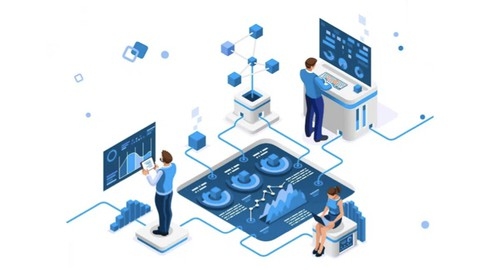Enterprise architecture is the practice of designing, planning, and managing the IT infrastructure of an organization.
It’s a crucial field that helps businesses align their technology with their strategic goals, ensuring efficient operations, enhanced productivity, and competitive advantage.
By understanding enterprise architecture principles and best practices, you can contribute to the development and implementation of robust, scalable, and secure IT systems.
Finding the right enterprise architecture course on Udemy can be a daunting task, with so many options available.
You’re looking for a program that’s comprehensive, engaging, and taught by experts, but also fits your learning style and goals.
You need to find a course that covers the fundamentals of enterprise architecture, but also delves into real-world applications and practical tools used by professionals.
For the best enterprise architecture course overall on Udemy, we recommend the Standard 9.2 - Part 1 Foundation Enterprise Architect Course.
This course provides a comprehensive overview of the TOGAF 9.2 standard, a widely recognized framework for enterprise architecture, equipping you with the knowledge and skills needed to understand and apply enterprise architecture principles in real-world scenarios.
The course covers the core concepts of TOGAF, including the Architecture Development Method (ADM), and includes practical exercises and quizzes to solidify your learning.
While this is our top pick, there are other great options available on Udemy that cater to different learning styles and goals.
Keep reading to discover our full list of recommendations, including courses on specific enterprise architecture frameworks, tools, and techniques.
Standard 9.2 - Part 1 Foundation Enterprise Architect Course
This course provides a thorough foundation in the TOGAF 9.2 standard, equipping you with the knowledge needed to understand and apply enterprise architecture principles.
You’ll start by diving into the core concepts, exploring the definition of an enterprise and the importance of the BDAT framework (Business, Data, Application, and Technology).
The course then delves into the heart of TOGAF: the Architecture Development Method (ADM).
You’ll gain a comprehensive understanding of each phase, from the initial architecture vision to the implementation of change management, with detailed explanations and examples.
Beyond the ADM, you’ll discover valuable insights into key TOGAF concepts such as architecture styles, principles, and patterns.
These practical applications will help you translate theoretical knowledge into real-world scenarios.
To solidify your learning, the course includes quizzes throughout, ensuring you grasp the key principles.
You’ll also have access to a practice test, allowing you to evaluate your preparedness for the TOGAF Foundation Certification exam.
The inclusion of slides and audio files provides valuable resources for review and reinforcement.
This course offers a structured and comprehensive approach to learning TOGAF 9.2, making it an excellent starting point for individuals seeking to gain a solid understanding of enterprise architecture principles and practices.
Software Architecture for the Enterprise Architect
This course lays a solid foundation for anyone aiming to become an enterprise architect.
You’ll go beyond the surface-level understanding of the role and delve into the critical aspects of bridging business needs with software solutions.
The course doesn’t shy away from the technical side, equipping you with the essential skills of UML modeling, a language used for designing software systems.
You’ll gain hands-on experience creating diagrams – think Component Diagrams, Class Diagrams, and Deployment Diagrams – to visualize and understand complex systems like a seasoned architect.
These skills are crucial for anyone navigating the intricacies of software architecture.
You’ll also explore the diverse world of architectural patterns, from the classic Multi-Tiered Architecture to the modern Microservices Architecture and Domain Driven Architecture.
This diverse approach ensures you’re ready to tackle real-world challenges with a toolbox of proven solutions.
Beyond the technical aspects, the course emphasizes the importance of team dynamics, ensuring you can effectively lead and collaborate with developers and stakeholders alike.
You’ll learn how to analyze business requirements, assess quality attributes, and make strategic decisions that shape the software’s success.
It’s a stepping stone to a rewarding career in software development, providing you with the knowledge and skills to confidently lead complex projects and shape the future of software systems.
Standard 9.2 - Part 2 Certified Enterprise Architect Course
If you’re aiming to become a TOGAF certified architect, this course offers a structured path to understanding the latest version of the Open Group Architecture Framework.
It focuses on the TOGAF 9.2 specification, which is the current standard for enterprise architecture.
You’ll dive deep into the Architecture Development Method (ADM), the heart of TOGAF.
This course explains the ADM phases in detail, demonstrating how to apply them to real-world scenarios, making the concepts less theoretical and more practical.
You’ll find quizzes throughout the course to reinforce your learning and build confidence for the TOGAF 9.2 Part 2 exam (OG0-092).
While the TOGAF 9.2 specification can be dense, this course breaks down the complex concepts into manageable lessons, making it easier to grasp.
However, keep in mind that the course emphasizes the exam, so if you’re seeking a comprehensive overview of TOGAF beyond the exam scope, you might need to supplement it with additional resources.
Standard 10.0 - Level 1 Enterprise Architect Course
You’ll gain a clear understanding of the differences between TOGAF 9.2 and TOGAF 10, as well as a solid foundation in the broader field of enterprise architecture.
The course meticulously breaks down the ADM’s phases, starting with preliminary planning and progressing through to implementation governance.
You’ll learn how to effectively apply architecture principles, engage stakeholders, and identify potential risks within your projects.
The syllabus also delves into crucial areas like gap analysis, migration planning techniques, and ensuring interoperability requirements.
You’ll gain valuable insights into the role of the architecture board, the importance of architecture contracts, and the significance of maintaining architecture compliance within a TOGAF framework.
The inclusion of a practice test further enhances the course’s value by providing you with a valuable opportunity to prepare for the TOGAF 10 Foundation Level certification.
This course provides you with the necessary knowledge and skills to confidently navigate the complex world of enterprise architecture.
Introduction to Sparx Enterprise Architect
This comprehensive course provides a deep dive into Sparx Enterprise Architect, a powerful tool for modeling and documenting software systems.
You’ll start by understanding the history and evolution of the software, along with the different modeling languages it supports.
Then, you’ll get hands-on with configuring your desktop environment, exploring the nuances of creating repositories, and learning how Sparx Enterprise Architect interacts with databases.
You’ll also get a thorough introduction to the key features of version 16, including new functionality and enhancements.
The course then delves into the core of modeling and diagramming, equipping you with the skills to effectively utilize Sparx Enterprise Architect’s various modeling elements.
You’ll learn how to create diverse diagrams, mastering both basic and advanced techniques.
Throughout this section, you’ll gain valuable insights into layout and modeling best practices, ensuring you develop efficient and effective workflows.
Next, you’ll learn to navigate the Sparx Enterprise Architect environment like a pro, mastering the use of the browser panel, model views, and traceability features.
You’ll discover powerful searching functions, explore navigation cells and composite diagrams, and gain a strong understanding of how to effectively leverage relationships within your models.
Finally, you’ll learn how to effectively publish your models, generating a range of documents and HTML reports tailored to your specific needs.
You’ll explore the flexibility of custom report generation, discover the power of linked and dynamic documents, and master the creation of professional-quality HTML publications.
The course also covers essential collaboration features, allowing you to work effectively with teams.
This includes topics like authorization, content locking, working sets, baselines, and releases, ensuring seamless teamwork and project management.
Enterprise Blockchain Architect Course
This comprehensive course dives deep into the world of blockchain, starting with the fundamentals and building up to a robust understanding of its architecture and applications.
You’ll gain a strong foundation in blockchain basics, covering topics like private and public keys, transactions, and smart contracts.
But this isn’t just theory; you’ll explore real-world examples, helping you grasp the practical implications of blockchain technology.
The course then delves into the fascinating world of blockchain platforms.
You’ll gain valuable insights into the unique architectures of leading platforms like Bitcoin, Ethereum, Hyperledger, and Corda, comparing and contrasting them to identify the best fit for different use cases.
This hands-on approach equips you with the knowledge to make informed decisions about blockchain implementation.
You’ll also dive into the fascinating world of blockchain architecture design patterns.
From the Verifier Pattern and Reverse Verifier Pattern to the Contract Registry Pattern, you’ll learn how to implement these techniques effectively to build secure and robust blockchain solutions.
The course doesn’t stop at theory.
You’ll learn the practical aspects of designing and building blockchain solutions, exploring important considerations like integration, risk management, and security.
You’ll gain a comprehensive understanding of blockchain architecture, covering deployment views, enterprise views, and additional components to ensure a well-rounded knowledge of the subject.
BPMN 2.0 for Enterprise Architects
You’ll learn how to use BPMN to understand, analyze, and design business processes with clarity and efficiency.
The curriculum goes beyond simply introducing BPMN elements.
You’ll delve into the nuances of various activities like Tasks, Sub-Processes, and Call Activities, gaining a deep understanding of how these elements work together to represent complex processes.
The emphasis on Swimlanes allows you to visualize roles and responsibilities, making your process models more collaborative and effective.
Beyond theory, this course encourages hands-on learning.
You’ll gain practical experience using popular BPMN tools like bpmn.io, diagrams.net, and Microsoft Visio, preparing you to confidently apply your knowledge in real-world projects.
The inclusion of BPMN case studies provides valuable insights into how to model real-life business scenarios, allowing you to solidify your understanding and build your skills through practical application.
This course is an excellent starting point for anyone interested in understanding and utilizing BPMN for process improvement and optimization.
Modeling an Enterprise Architecture
This course is your comprehensive guide to building and managing enterprise architectures using Sparx Enterprise Architect and the industry-standard ArchiMate language.
You’ll start by diving into the core of Sparx Enterprise Architect, learning how to configure the software for your specific needs and create robust models using ArchiMate.
The course covers everything from the basics of ArchiMate, including its metamodel, views, and viewpoints, to advanced modeling concepts like nesting and junctions.
Throughout the course, you’ll gain a deep understanding of the four core layers of ArchiMate – Business, Application, Technology, and Physical – along with the motivations behind them, such as Strategy and Implementation & Migration.
But this isn’t just theory.
You’ll also learn to leverage Sparx Enterprise Architect’s powerful features for ArchiMate modeling, including matrix and swimminglanes, glossary management, documentation generation, and even time-aware modeling for architecture plateaus.
This course provides a structured approach to learning enterprise architecture, with quizzes along the way to reinforce your understanding and ensure you’re on the right track.








